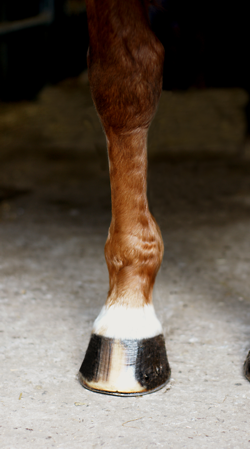Keeping your horse's hooves healthy and strong
Caring for horses and ponies means attention to every aspect of ‘top-to-toe’ management, with hoof health featuring high on the list of priorities. At this time of year, when ground conditions can vary from dry and firm to wet and soft, sometimes in the same week, along with a seasonally increased workload, these 10 important hoof care tips will help you keep your horse’s hooves both healthy and strong.

Pick out your horse's feet regularly
Fairly basic, but it's the most important thing you can do for your horse’s hooves. Do it to remove small stones and other objects in his feet before – and after - riding, to check on his shoes, look for turnout injuries, check for heat and/or a digital pulse, remove droppings before turnout and keep an eye out for early signs of thrush.
Each time you clean your horse's hooves, after you've removed any packed debris, take time to gently clear the crevice of the frog and scrape any remaining bits off the sole with the tip of the pick. You ideally want to be able to see the sole's entire surface, so finish the job with a stiff brush. Some hoof picks come with brush attached, or you can buy a brush separately and inexpensively.
Establish what's normal
While handling your horse's feet to pick them out, notice their temperature; when everything's healthy they'll feel very slightly warm. Locate the digital pulse with two fingers pressed against the back of his pastern; you're interested not in the rate of the pulse, but in its strength under normal conditions. Check the frog, which has about the texture and firmness of a new pencil rubber when it's healthy. If the frog appears to be peeling off, remember that most horses shed the frog at least twice a year, sometimes more often. Your farrier's regular trimming may have prevented you noticing this natural process before.
When picking out the feet, look for signs of...
Thrush - The first clue to this bacterial condition (usually caused by prolonged standing in droppings, mud, or other wet, filthy conditions, or even by prolonged use of pads) is a foul smell and dark ooze from the cleft of the frog. Later, the frog becomes cheesy in texture. Although thrush can eventually cause lameness and significant hoof damage, its early stage is simple to treat – ask your farrier or vet for advice - and make sure your horse's stable is clean and dry.
Puncture - If a nail or other object pierces your horse's sole and then falls out, the entry wound will probably be invisible by the time you pick his feet and you'll be unaware of it until it causes an abscess. But in some cases the object remains in place, to be discovered when you brush the last bits of dirt from the sole. DON'T PULL IT OUT. Put your horse in his stable (protect the punctured foot, and help the foreign object stay put, with wrapping and duct tape, or with a slip-on medication boot), and call your vet immediately to remove the object and advise a course of treatment.
Cracks - Some cracks are superficial; others can worsen to involve sensitive hoof structures, without appropriate shoeing. One cause of a crack is a hoof abscess which breaks out through the coronet band at the top of the hoof, creating a weak spot in the hoof wall that must be attended to as it grows out. If you notice a crack in your horse's hoof, call your farrier and describe its location and size so he can decide whether it needs attention now or can wait until the next regular shoeing.
Abscess - If your horse's digital pulse feels stronger than usual and/or his foot is warmer than normal to the touch, the cause could be an abscess inside the hoof from a badly placed shoeing nail, a bruise, or an overlooked sole puncture. Your routine check can alert you to the problem and get your vet or farrier involved before your horse--probably at least slightly lame already on the abscessed foot, which throbs from the pressure of increased blood flow to the infected area--is in even greater pain. (If you find increased heat and a stronger-than-usual digital pulse in both front feet, and if he's shifting uncomfortably from foot to foot, call your vet immediately. These are signs of laminitis, an inflammatory condition that can cause severe hoof damage--and, if not treated promptly, can even be fatal.
Schedule regular farrier visits according to your horse's individual needs
Although six to eight weeks is the average, there's really no standard interval for trimming and shoeing. If your farrier is correcting for a problem such as under-run heels or flare in the hoof wall, your horse may benefit from a shorter interval. If everything looks fine but you notice that he begins forging--striking the back of a front hoof with the toe of a back hoof (you'll hear a metallic sound)--in the last few days before his next shoeing, ask your farrier whether a shorter schedule might avoid the problem--possibly four to five weeks in the summer, slightly longer in the winter.
If your horse is shod, check his shoes each time you pick out his feet and check for...
Risen clenches - The ends of the nails your farrier trimmed and clinched (bent flush with the outer hoof wall) at his last shoeing are now sticking out from the hoof. This is a sign the shoe is loosening, probably because it's been in place for several weeks; he can injure himself if the risen clinches on one foot brush the inside of the other leg.
A sprung or twisted shoe - Instead of sitting flat on your horse's hoof, if the shoe is pulled away and perhaps even bent, it's sprung. If it's moved to one side or the other, it's twisted. In either case, the nails in the problem shoe can press on sensitive hoof structures when your horse places weight on the foot.
Learn how to remove a shoe
Many farriers are glad to teach clients how to do this and explain which tools to use, and which you can buy inexpensively. If you can remove a sprung or twisted shoe, you may save your horse unnecessary pain and hoof damage and make life easier for your farrier or vet.
Help your horse grow the best possible hooves
Some horses naturally have better hooves than others. Your horse may already be producing the best hoof he's capable of, but the following suggestions may enable him to grow better quality hooves.
Fine-tune his diet - Ask your usual nutritional advisor whether your feeding regime is appropriate for your horse's nutritional needs.
Consider adding a supplement to his ration - particularly if you know that your usual forage lacks important minerals. Your vet, farrier and nutritional advisor will all be able to make a recommendation, but it’s worth noting that whilst some hooves benefit from these supplements; others show little change. Plan to use the supplement for six months to a year as that's how long it can take for any benefits to show up in new hoof growth.
Give him consistent exercise - Working on good surfaces, especially at walk and trot, increases circulation to your horse's hooves and promotes growth.
Avoid the ‘summer cycle’ of alternate soaking and drying of hooves
Your horse's hooves can adapt well over time to conditions that are consistently dry or consistently damp, but hooves suffer when the environment fluctuates between wet and dry. Unfortunately, this is often the situation during the very months when you want to ride him the most: late spring, summer, and early autumn. Evening turnout - a summer strategy to avoid biting insects - puts hooves in prolonged contact with dew-soaked grass; they swell and soften with moisture, much as your fingernails soften after hours in water. Back in a dry, hot environment during the day, the hooves dry and contract. With repetition of this cycle, horseshoe nails loosen as their holes through the hoof wall enlarge slightly. Summer activities, including work, stamping at flies, or excessive activity in the field all accelerate the loosening – and your horse will potentially lose shoes more often. A lost shoe often means hoof damage, which escalates the cycle of summer shoeing problems. Shortening your regular shoeing interval by a week at this time of year may help avoid unwanted emergency calls.
Try not to turn out in deep, muddy footing
Hours of standing in mud may encourage thrush or mud fever – even at this time of year! Mud is hard on shoes, too: The suction of deep mud can drag off a shoe already loosened by alternating wet and dry conditions. Mud also makes picking up his feet a harder job for a moving horse, so if your horse is slow about getting his front feet out of the way, he may end up pulling off the heels of his front shoes because he's stepping on them with his back toes.
Protect your horse's hooves when travelling
Without covering for his heels, he can easily step on the edge of a shoe and pull it partially loose--then spend the remainder of the journey standing on the nails of the sprung or twisted shoe. Another vulnerable area is the coronet band: the rim of tissue at the top of each hoof that generates new hoof-wall growth. Injury to this area (for instance, if he steps on himself while struggling to keep his balance whilst travelling) can interrupt hoof growth in the area below the affected spot.
This article first appeared in the August issue of Equine. If you would like to read more of these expert Paddock Perfection articles in Equine magazine, back issues are available for secure online purchase from www.theeequinestore.co.uk where you can also subscribe to Equine.



